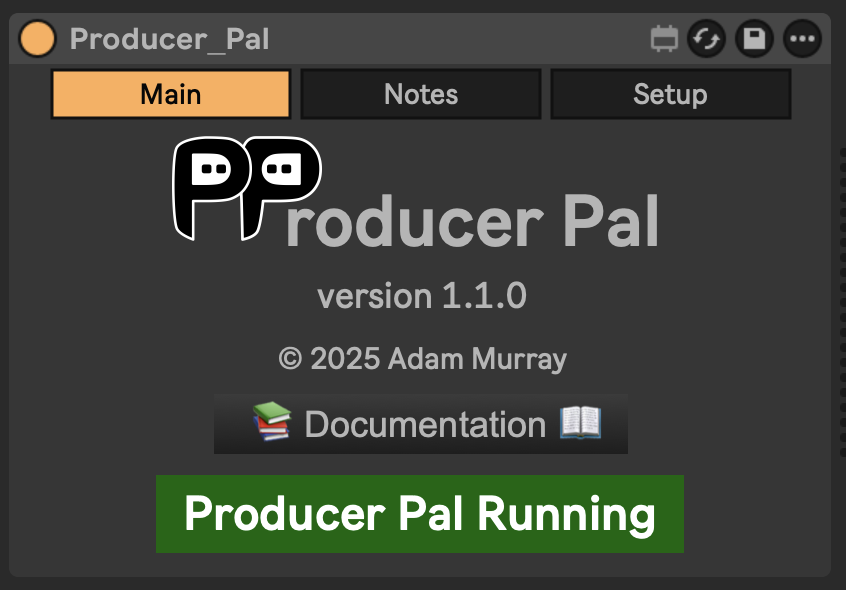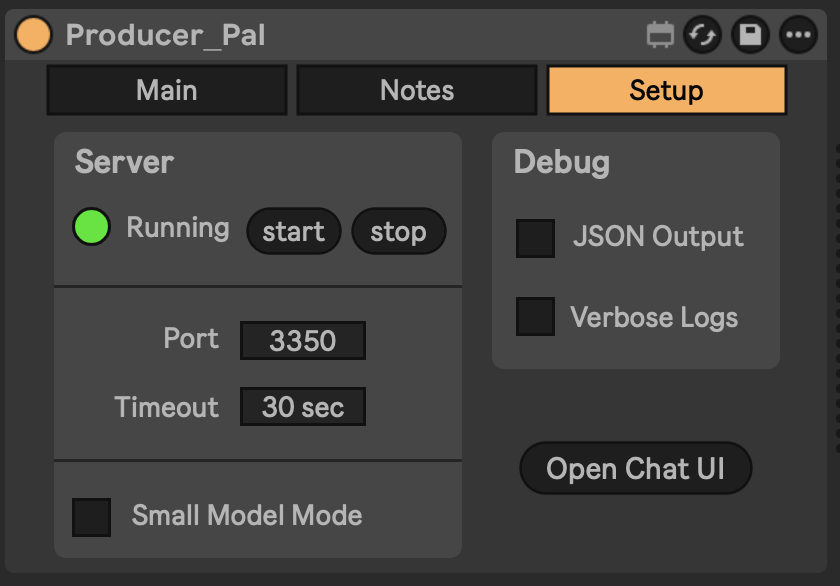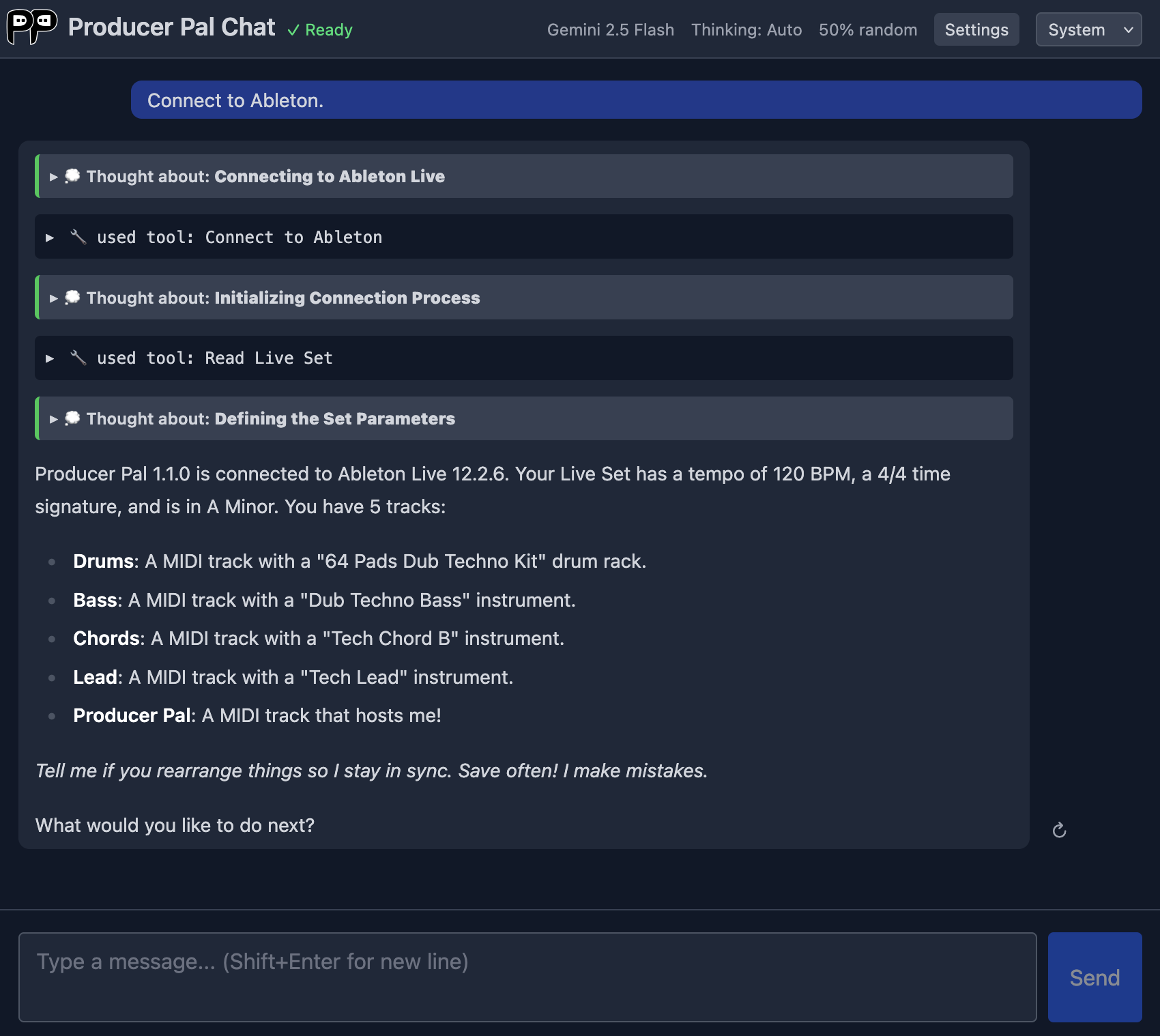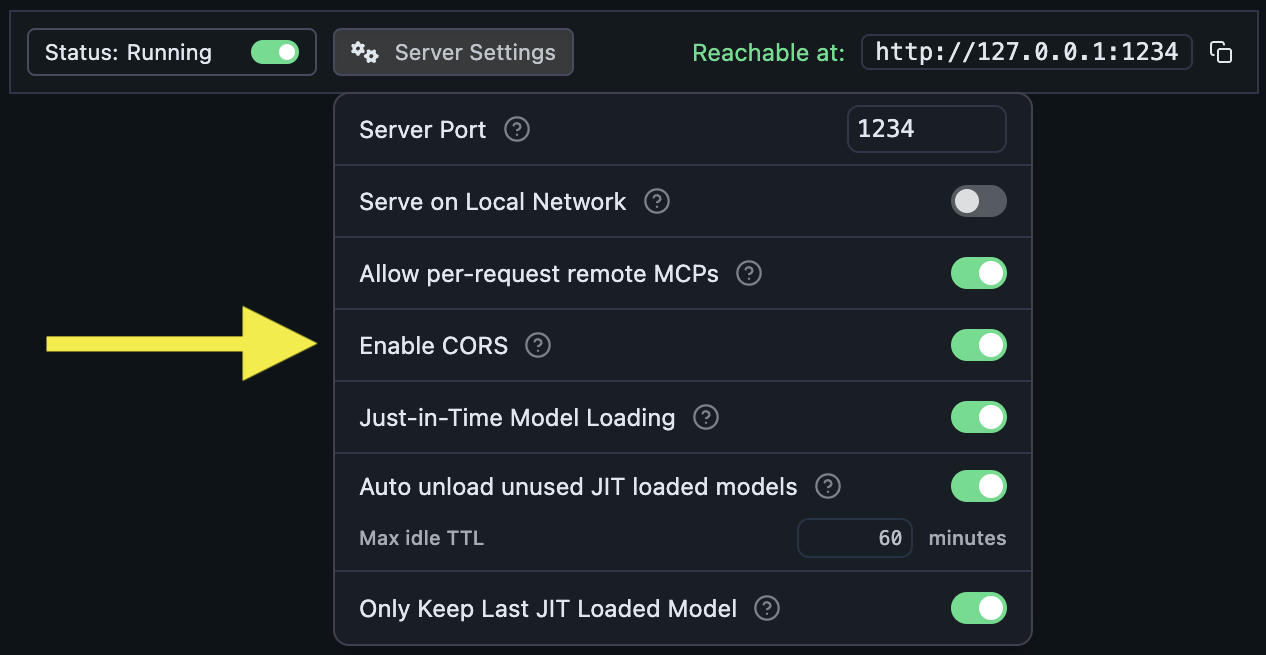Producer Pal Chat UI
Producer Pal includes its own chat interface, independent from Claude Desktop, Gemini CLI, or any other AI platform. The chat UI is served as a web page from the Max for Live device and opens in your system's default browser.
The chat UI supports multiple LLM providers including Google Gemini, OpenAI, Mistral, OpenRouter, local models via LM Studio and Ollama, and custom OpenAI-compatible providers.
Using the built-in chat UI with Google Gemini's free tier is one of the easiest (and recommended) ways to use Producer Pal.
Cost
Note: Some options use pay-as-you-go pricing for API access, which can incur cost quickly when using advanced models and having long conversations. Always monitor your API key usage when using pay-as-you-go options.
Requirements
- Ableton Live 12.2+ with Max for Live
- Any LLM API that supports tools and has an OpenAI-compatible interface, or Google's Gemini API
Choose from these options:
Online LLM APIs
- Google Gemini API (recommended): All Google accounts can use the free tier with generous daily quotas. Get a Gemini API key.
- OpenAI API: Requires pay-as-you-go pricing. Get an OpenAI API key. Also consider Codex CLI to use OpenAI with Producer Pal on a subscription plan (flat rate, not pay-as-you-go).
- Mistral: AI developed in France. Can be used for free but with fairly aggressive quotas. Get a Mistral API key.
- OpenRouter: An "AI gateway" with hundreds of LLMs available in one place. Includes free and pay-as-you-go options. Get an OpenRouter API key.
- Custom: Any other compatible LLM. See Using Custom Providers.
Offline LLMs
Run models locally:
Installation Steps
1. Install the Max for Live Device
Download Producer_Pal.amxd, the Producer Pal Max for Live device, and add it to a MIDI track in Ableton Live:

It should display "Producer Pal Running" or something isn't working.
2. Open the Chat UI
Open the "Setup" tab in the device and click "Open Chat UI", which will open http://localhost:3350/chat (or whatever port Producer Pal is setup to use)

3. Configure Your LLM
If it's your first time, choose a provider, enter an API key (if using an online LLM), and choose a model. See below for examples and more info about the various settings. Once you've configured your settings, click "Save".
4. Start Chatting
Click the "Quick Connect" button to start a chat:

Or type whatever you want into the text input.
The chat UI connects directly to your chosen LLM provider's API and uses Producer Pal's MCP tools automatically.
Privacy Note
For Online APIs Your API key is stored in the browser's local storage for convenience. If that concerns you, use a private browser session, delete the key from settings after use, or delete browser local storage after use. You can delete and regenerate API keys with the AI provider if a key is accidentally shared.
Chat UI Model Settings
Thinking
Some models support extended reasoning where they "think through" problems before responding. This increases response time and token usage but can improve quality for complex tasks. Enable if your model supports it and you need more sophisticated musical decisions. Some reasoning models, such as Gemini, support showing their "thoughts".
Randomness (0%-100%)
Controls AI response randomness. Lower values (0% - 50%) make the model more focused and deterministic. Higher values (50% - 100%) make it more creative but potentially less coherent. Default is 50%. For music composition, try higher values depending on how experimental you want the results.
Using Local Providers
LM Studio with the Producer Pal Chat UI
You can use LM Studio with the built-in chat UI as explained here, or you can use LM Studio's UI if you prefer.
Install LM Studio and download some models
Go to the LM Studio developer tab
Open Server Settings and Enable CORS. Producer Pal's chat UI runs in the browser and cannot directly connect to LM Studio without this option:

Start LM Studio server. It should say: "Status: Running"
Configure the Producer Pal Chat UI:
- Provider: LM Studio (local)
- Port: 1234 (This is the default. If you change it in LM Studio settings, change this setting to match)
- Model: A model that supports tools, such as
qwen/qwen3-vl-8b,openai/gpt-oss-20b, ormistralai/magistral-small-2509
Model Tool Support
If the model responds with garbled text like
<|tool_call_start|>...or says it has no way of connecting to Ableton, the model likely doesn't support tools. Try a different model. Look for a hammer icon next to the model:
Save the Chat UI settings and use the Quick Connect button to start a conversation.
See the LM Studio install guide for tips on choosing and configuring models with LM Studio. It's recommended you enable the "Small Model Mode" option in the Producer Pal Setup tab for better compatibility with local models.
Ollama
- Install Ollama
- If you haven't already, run Ollama, select some of the downloadable (non-cloud) models, and start a chat with them to download them.
- With Ollama running, configure the Producer Pal Chat UI:
- Provider: Ollama (local)
- Port: 11434 (This is the default. You generally don't need to change this)
- Model: A model that supports tools, such as
qwen3-vl:8b,qwen-3-coder, orgpt-oss:20b
- Save the Chat UI settings and use the Quick Connect button to start a conversation.
Using Custom Providers
To use other OpenAI-compatible providers beyond the built-in options:
- Open the chat UI settings
- Select "Custom (OpenAI-compatible)" as the provider
- Enter your API key
- Set the Base URL for your provider
- Enter the model name
Custom Provider Example: Groq
- Provider: Custom (OpenAI-compatible)
- Base URL:
https://api.groq.com/openai/v1 - Model:
moonshotai/kimi-k2-instruct(or other available models likeopenai/gpt-oss-120b,qwen/qwen3-32b)
Troubleshooting
If it doesn't work, see the Troubleshooting Guide.